My mind wanders when riding and today’s thoughts, when battling through a ferocious headwind, was just how much difference was it actually making? This thought stayed with me once home and dry, so I decided to find out. As I wasn’t in a position to hire a wind tunnel for my investigation, I turned to the next best thing I could find – this Bike Calculator. As an amateur, you have to trust the best information available to you. So, one man, one spreadsheet and a lot of numbers!
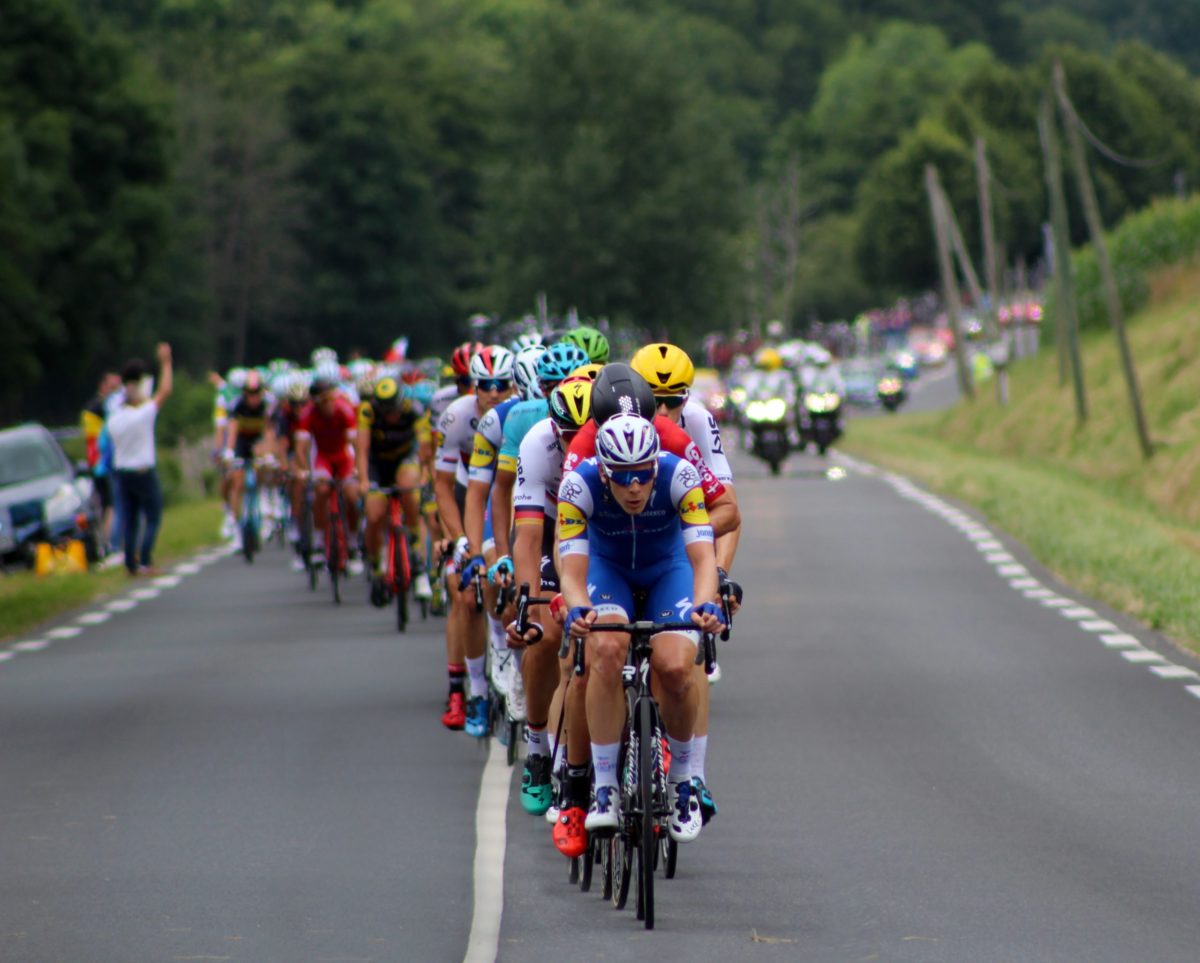
Assumptions
In order to focus primarily on headwind, power and rider position, I kept the following elements constant:
Bike Weight: 8.3kg. The average weight of the top 10 bikes in road.cc’s 2016 bike of the year.
Rider Weight: 84kg. The average weight of a man of in the UK according to 2010’s ONS figures.
Tyres: Clinchers. I felt these were more common than tubeless tyres.
Elevation: The elevation has been kept at a constant 100m above sea level to avoid air pressure changing the results.
The Scenarios
Riding In The Hoods
For the first scenario, we are riding along on the flat in the hoods when we turn to face a headwind. Our power output is 180w which, given the variables above, means we are riding at 30.14 km/h. As we turn into the wind we maintain our power output. For each 5km/h of additional headwind you can see we are losing about 10% of speed. At a head wind of 30.48 km/h we would have lost half of our initial speed slowing down to 15.07 km/h.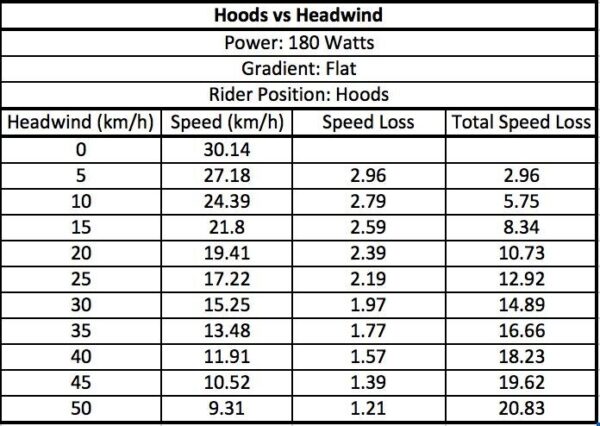
This drop-in speed really surprised me. I thought it was as much in my head as in reality, but this proves not to be the case.
Riding In The Drops
The drops give a more aerodynamic position by bringing your body downwards so with less frontal area hitting the wind, as you would expect, your speed is naturally maintained better. This table compares riding in the hoods vs the drops.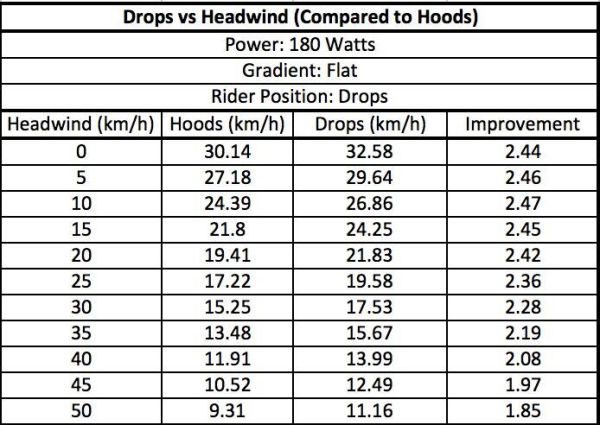
With our variables above at 180w on the flat with no headwind, we’re getting a boost of just under 2.5km/h which was more significant than I expected. What’s interesting is that the stronger the wind, the greater the benefits of being in the drops.
You can see from the chart ‘Improvement vs Hoods %’ the difference this makes; with no headwind, the speed improvement at 180w is 7.49%, but take that up to 25km/h and you are saving yourself 12.05%. Into a 50 km/h headwind the drops are going to save you 16.58%.
How Much Additional Power Do We Need To Account For A Headwind?
If you’re like me then you’re not going to let Mother Nature defeat you this easily, so naturally, we’re going to put a bit of extra power through the cranks. But how much extra do we need to account for those headwinds?
Assuming you stick in the hoods as you turn into the wind and want to maintain your flat 180w non-headwind speed of 30.14 km/h, you are going to have to find some serious power to make up for the headwind. Into a 5 km/h headwind this equates to an additional 50w meaning you need to push out 230w. Unfortunately this does not ramp up in a linear way as by the time you hit 20km/h (4x the headwind) you need to push out an additional 248w (nearly 5x the wattage at 5km/h)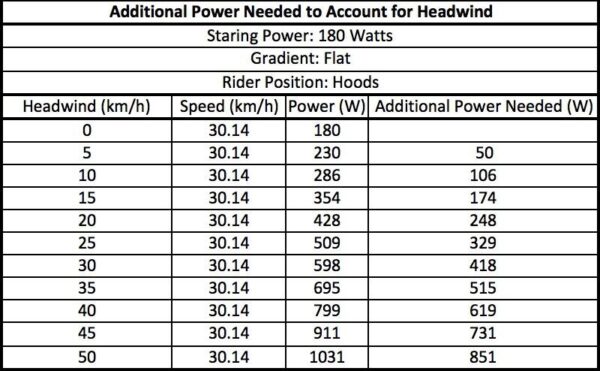 This makes maintaining a constant speed in a headwind pretty challenging especially when riding by yourself. On a group ride it gets a bit easier as studies have shown riding in a group can save up to 40% of a rider’s energy, meaning by taking turns, maintaining a faster speed should be easier.
This makes maintaining a constant speed in a headwind pretty challenging especially when riding by yourself. On a group ride it gets a bit easier as studies have shown riding in a group can save up to 40% of a rider’s energy, meaning by taking turns, maintaining a faster speed should be easier.
Saving Power By Changing To The Drops When We Hit A Headwind
Let’s say we are cycling along on the flat, hands on the hoods, when we hit a headwind. We immediately change into the drops knowing it is going to save us power and make our ride into the wind easier. Once again the aim is to keep our speed constant at 30.14 km/h.
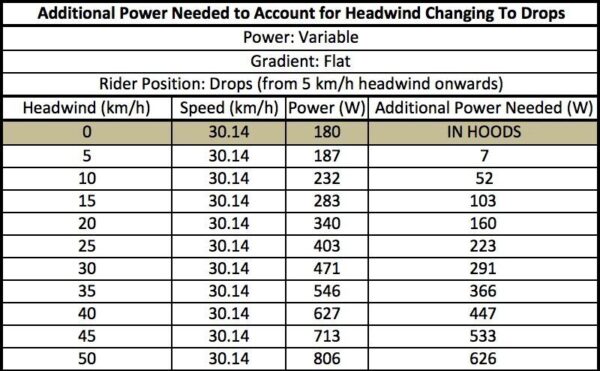
You can see from the table what a power saving changing to the drops gives us. In a 5 km/h headwind, if we’d stayed in the hoods we would have had to put in 230w to maintain our speed, but by changing to the drops we only need 187w, which is only 7w more than our starting power.
The initial saving is 18.7% by changing to the drops, but this rises as high as a 22% saving if you head into a 50 km/h headwind (and if you can find an extra 626w from somewhere!)
You can start to see from this data the tangible difference you can make to your speed by getting into a more aerodynamic position when you hit a headwind.
How Does Riding Into A Headwind Compare To Riding Uphill?
This is another question often debated when out riding. We’ve all been there, thinking, “that headwind was awful today, like riding up a 10% hill”. But was it?
Each 5 km/h increase in headwind is equivalent to a gradient increase of around 0.57%. I’ve measured this by keeping the power at 180w and reviewing the speed lost by the headwind/gradient variables. Once again you can see how much effort it takes to ride into a headwind. Whilst I thought the equivalent gradient might be a bit more than this, it does hammer home the point of how hard you are working.
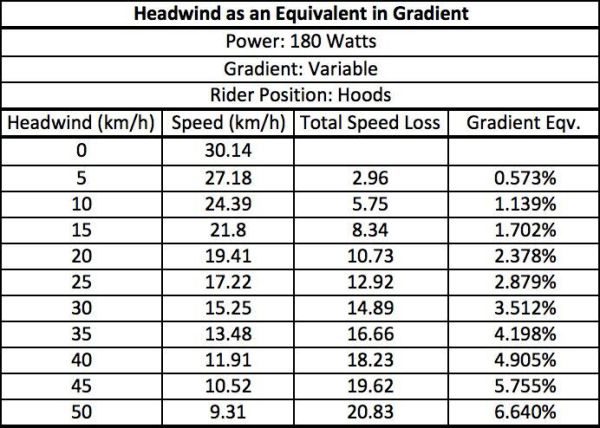
How Does This Translate To The Real World?
Well, the reality is that it doesn’t. There are so many variables in the above data that it would be impossible to match any scenario perfectly. Take the air resistance generated by the headwind. This alone would throw up a number of questions:
- Was the wind directly towards us?
- Did it remain at a constant km/h?
- Were we sheltered at any point by cars/trees/other riders etc?
- Did we hold our shape perfectly on the bike?
So as you can see, measuring headwind resistance is never going to be an exact science, and certainly not when it’s just me and my data! But to put your new found knowledge into practise, here are some tips to help make the best of a bad situation when cycling into a headwind:
- Try to make yourself as aerodynamic as possible. As well as riding on the drops, tuck your elbows in, wear tight fitting clothing and keep your head still to cut through the wind more easily.
- Try and keep your cadence high. Just like cycling uphill, drop down gears to keep your cadence above 80RPM. Don’t be embarrassed to change into the smaller front ring if needed as a high cadence will keep your legs fresher.
- Plan your route and timing. I always prefer to head out into the wind so there’s something to look forward to on the way back. Check the weather forecast the night before and plan a route based on the main wind direction. Generally, the wind is calmer the earlier in the day so consider setting off early.
- Be careful with cross winds. Wind is rarely constant, and on a strong, blustery day it can easily knock you off course. Be aware of the direction the wind is coming from, and look for potential hazards that could cause the wind to send you sideways like gaps in the hedge-line or a passing lorry.
- Ride in a group. You can save a lot of effort by sheltering in a bunch, just make sure you do your fair share of time on the front.
- Learn to love it! I’m an optimist but even I won’t pretend I’ve got a big smile plastered on my face when it’s really bad. However, the more you can improve your attitude to bad conditions the better it will feel – your mind will give up long before your body needs to and whilst riding into a headwind doesn’t look pretty on Strava, you’ll reap the physical benefits of challenging conditions.
Across three packages, our Bicycle Insurance covers your equipment when riding, racing or training worldwide.